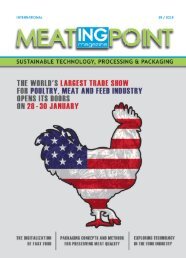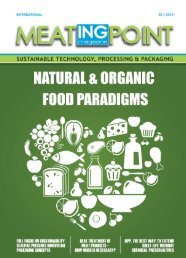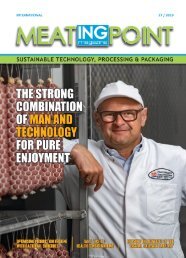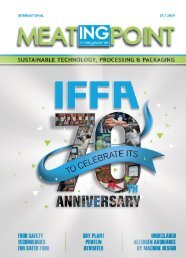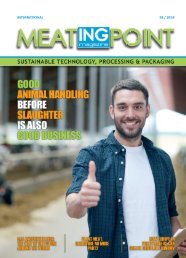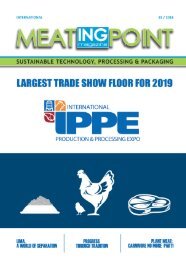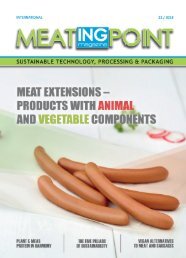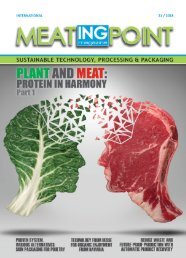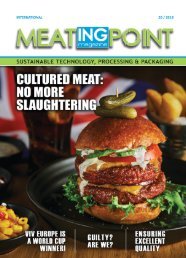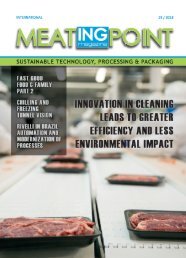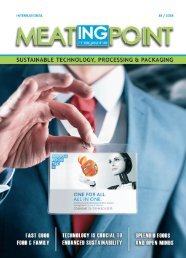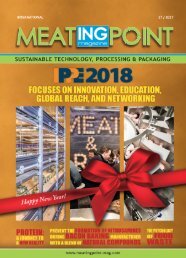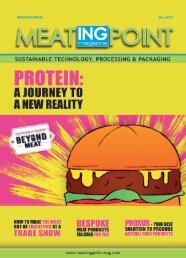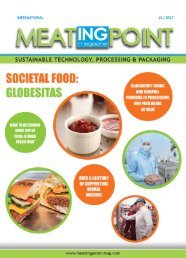MEATing POINT Magazine: #05/ 2015
Create successful ePaper yourself
Turn your PDF publications into a flip-book with our unique Google optimized e-Paper software.
... CONSUMER TRENDS ...<br />
Hybrid Burgers gain popularity<br />
by Henk W. Hoogenkamp Part 2<br />
The rapid global population<br />
growth puts pressure<br />
on the available food<br />
resources.<br />
Subsequently,<br />
innovative technology needs to be<br />
implemented to increase food and<br />
meat production without damaging<br />
the ecological infrastructure.<br />
Manufacturing hybrid-meat<br />
products is such an example of<br />
how to safeguard sustainability,<br />
nutrition, and affordability.<br />
Going Forward<br />
Before discussing processing<br />
equipment and its relation to<br />
functional ingredient interactions,<br />
it is best to first tackle the meat<br />
of the matter: “Knowledge is not<br />
power. The power of knowledge is<br />
in its application.” Breakthrough<br />
innovations are rare, and are seldom<br />
immediately propelled into the<br />
limelight. Smaller entrepreneurial<br />
companies searching for an edge<br />
are usually compelled to experiment<br />
with innovative ideas and techniques.<br />
Apparently, innovation is usually an<br />
incremental step forward, based on<br />
existing designs and ingredients.<br />
In response, equipment innovation<br />
and novel ingredient applications<br />
have come to the fore. Several<br />
recently introduced forming,<br />
shaping, and portioning machines<br />
underline what the next generation of<br />
equipment can do. For example, the<br />
RevoPortioner (Marel) is an example<br />
of a groundbreaking innovation<br />
that showcases environmental<br />
sustainability coupled with cost<br />
efficiency.<br />
the meat dough according to the<br />
contours and dimensions of the<br />
forming cylinder; the drum uses air<br />
to release the product; and, water is<br />
not needed. This is advantageous for<br />
product quality, process control, and<br />
worker safety, not to mention being<br />
environmentally ahead of the curve.<br />
Ground meat or formulated-meat<br />
dough is then pressed at low pressure<br />
from the pump unit into the portioner<br />
Processing innovations should be<br />
related to operational savings,<br />
product safety, and primarily<br />
reduction of environmental footprint.<br />
For example, faster throughput,<br />
greater yields and more accurate<br />
portion control needs to be modeled<br />
to require less energy, less water, and<br />
reduce waste. These are the buzzwords<br />
that trigger interest and acceptance<br />
among manufacturers and consumers<br />
alike. Of course, producing more at a<br />
lower cost is a goal all processors try<br />
to achieve, generally with a multitude<br />
of process-optimization tactics.<br />
Being an equipment innovator,<br />
however, requires real out-of-the-box<br />
thinking and a deep familiarity with<br />
fundamental design principles. It also<br />
requires a level of honesty to sort out<br />
which trends truly match the needs of<br />
the processors and consumers.<br />
The most eye-catching innovation for<br />
forming and portioning meat and<br />
food is the new portioning technology<br />
that uses a shaping mechanism<br />
controlled by variable pressure that<br />
retains shape, dimension, and weight<br />
accuracy. This new wave of portioning<br />
equipment like the RevoPortioner<br />
operates on a low-pressure principle<br />
– same as how old-fashioned cookie<br />
dough former allows topographicallyshaped<br />
products that freely exit the<br />
forming cavity with minimal force and<br />
no water spraying. These portioning<br />
machines operate with barely any<br />
noise, a blessing for in-plant operators.<br />
Here is how the RevoPortioner<br />
operates: The machine positions<br />
RevoPortioner (Marel)<br />
distribution housing, at the end of<br />
which is a continuously-rotating<br />
forming cylinder. The filled form then<br />
turns through a blade that assures<br />
proper shape configuration. Finally,<br />
airflows move the product from the<br />
cylinder or roller and are picked up by<br />
a conveyor belt.<br />
This new technology adds another<br />
level of expertise to the world of<br />
further processing:<br />
• Accurate shape and weight<br />
dimensions<br />
• Improved thermal processing<br />
conditions<br />
• Higher portioning temperatures<br />
26 | www.meatingpoint - mag.com | <strong>2015</strong> | Issue 5




